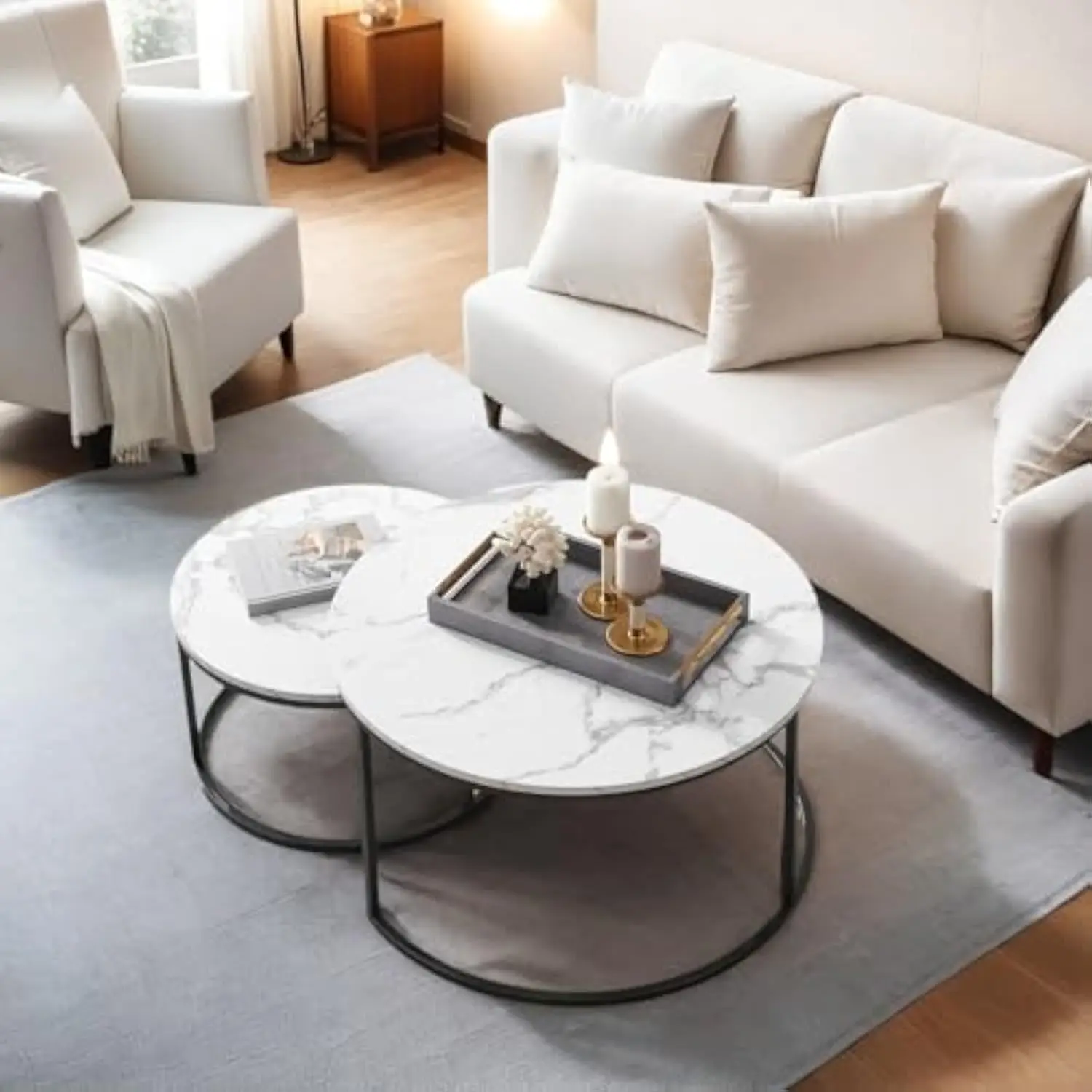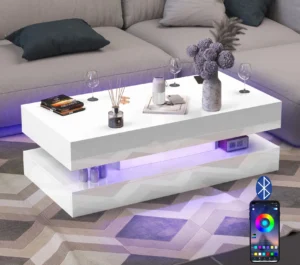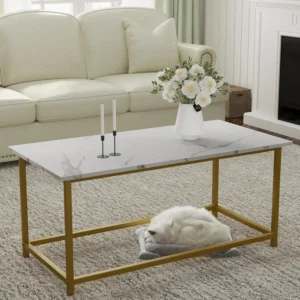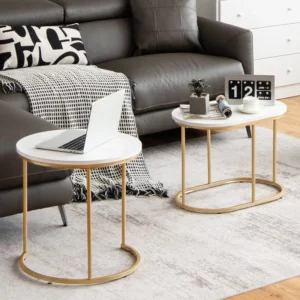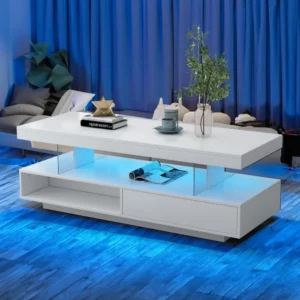Introduction: The Functional Elegance of Nesting Coffee Tables
Nesting coffee tables are sets of stackable tables in varying sizes that fit neatly together when not in use, creating a single cohesive unit that can be expanded as needed. These versatile pieces represent the perfect marriage of form and function in home furnishings – they save valuable floor space while simultaneously serving as distinctive design elements that enhance your living area.
The beauty of nesting coffee tables lies in their adaptability. In compact apartments, they provide crucial space-saving benefits without sacrificing style or utility. In more spacious homes, they offer flexible options for entertaining or creating visual interest through varied arrangements. When guests arrive, you can easily pull out additional surfaces for drinks and snacks; when you’re alone, you can keep the tables nested for a cleaner look.
Originally appearing in the early 20th century, space-saving nesting coffee tables have evolved significantly from purely practical pieces into statement furniture that anchors living spaces. Today, they come in countless variations of shapes, materials, styles, and functional features to complement any interior design approach.
At Hearth Forms, our passion for authentic mid-century modern design informs our carefully curated collection of nesting tables. Each piece is selected for its genuine proportions, quality construction, and material integrity – reflecting our commitment to functional art that transforms spaces.
The Essential Benefits: Why Nesting Coffee Tables Are Design Must-Haves
The enduring popularity of nesting coffee tables stems from their exceptional versatility and practical advantages that enhance modern living spaces:
Space Optimization
– Create an illusion of openness in compact rooms by keeping tables nested when not needed
– Provide flexible surface area that can expand instantly for entertaining
– Allow for reconfiguration based on changing needs without permanent commitment to larger pieces
– Function as both primary coffee tables and supplementary accent tables
Functional Adaptability
– Offer multiple surfaces for different activities (one for drinks, another for books, a third for decor)
– Enable separation of tables to serve different areas of a room simultaneously
– Accommodate varying height needs for different activities
– Provide temporary workspaces when needed without dedicated furniture
The design versatility of nesting tables as space-saving solutions makes them particularly valuable in today’s homes where multifunctionality is prized. Unlike standalone coffee tables, nested sets create visual dimension through layering, allowing you to introduce complementary or contrasting design elements that add richness to your décor.
Many homeowners find that investing in quality nesting tables offers better value than purchasing separate accent tables, as they provide multiple pieces with cohesive design language for approximately the price of one premium coffee table.
Round & Organic Designs: Softening Your Space with Fluid Forms
Round nesting coffee tables bring a gentle fluidity to living spaces, creating natural flow and softening environments dominated by straight lines and angular furniture. Their curved silhouettes provide visual relief and encourage movement around the room, making them ideal counterpoints to rectangular sofas and rectilinear layouts.
Popular Round Nesting Configurations:
– Classic concentric circles that nest perfectly within each other, creating a tiered effect when displayed
– Asymmetrical circular sets with varied heights and slightly different diameters for artistic interest
– Half-moon and crescent designs that offer space-efficient alternatives for placement against walls
– Free-form organic shapes with gentle curves that create a sculptural, artistic presence
Round designs from the mid-century modern round coffee tables collection showcase the perfect balance of form and function. These pieces typically feature tapered legs that angle outward, creating a sense of lightness despite solid construction. Edge treatments range from simple rounded profiles to more elaborate waterfall edges that emphasize the craftsmanship.
Material combinations that particularly enhance round designs include glass tops supported by wooden bases, which create an airy feeling while maintaining visual warmth. These tables work beautifully in transitional interiors, contemporary spaces, and of course, authentic mid-century settings where organic forms are celebrated.
Rectangular & Square Designs: Structured Elegance for Modern Spaces
For those who prefer clean lines and geometric precision, rectangular and square nesting coffee tables offer structured elegance that complements contemporary interiors. These designs maximize usable surface area while maintaining a sense of order and intention in your living space.
Rectangular and Square Configurations:
– Staggered rectangular sets with graduated lengths that create visual rhythm when nested
– Perfect square sets that offer proportional harmony and maximum efficiency
– Linear arrangements ideal for narrow living rooms or hallways where space optimization is crucial
– Sets combining squares and rectangles for varied visual interest
The beauty of mid-century modern rectangular coffee tables lies in their deceptive simplicity. While the basic forms remain clean and uncluttered, details like mitred corners, inlaid patterns, and thoughtfully designed supports elevate them from basic to extraordinary.
These geometric designs excel in modern and minimalist interiors where their clean lines reinforce the architectural elements of the space. They provide stable surfaces for everyday use while maintaining visual cohesion when nested. The proportional relationships between tables in a well-designed set create a pleasing visual rhythm, with each piece typically two-thirds to three-quarters the size of the next larger table.
Geometric Statement Pieces: Bold Shapes for Distinctive Interiors
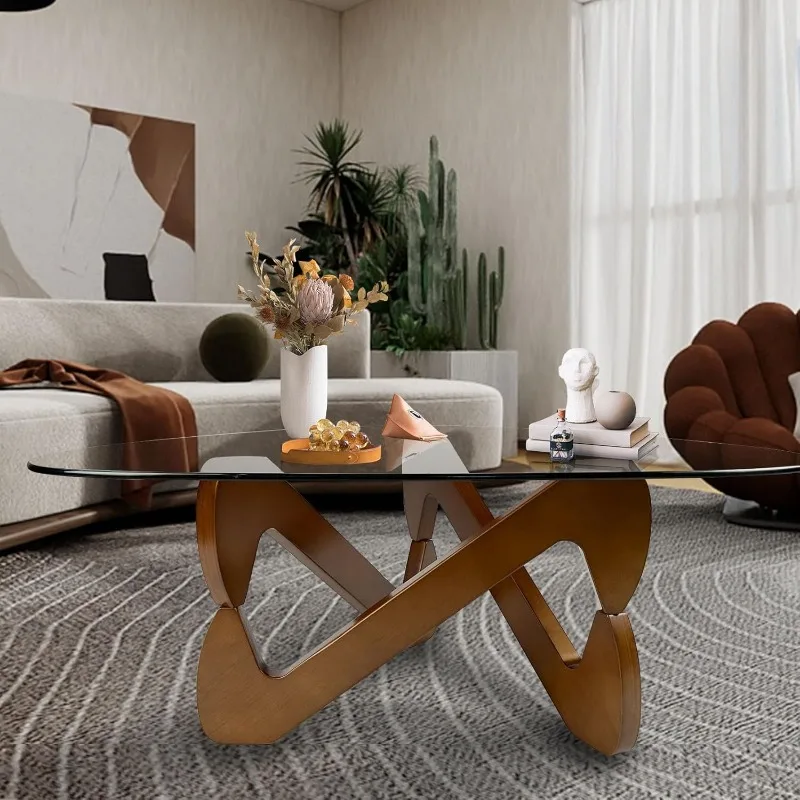
For those seeking to make a bold design statement, unconventional geometric nesting tables transform functional furniture into conversation-starting focal points. These distinctive pieces break free from traditional circular and rectangular forms to introduce architectural interest and artistic presence.
Striking Geometric Configurations:
– Hexagonal and octagonal sets that echo architectural details and create visual interest
– Triangular and wedge-shaped designs that nest with mathematical precision
– Multi-level arrangements with unexpected angles and intersecting planes
– Asymmetrical forms that function as sculptural elements while still providing practical surfaces
Glass top coffee tables with geometric designs are particularly effective as they allow light to play through their transparent surfaces, creating fascinating shadows and reflections that change throughout the day. The visual lightness of glass balances the potential heaviness of unusual geometric shapes, maintaining an open feeling in the room.
These statement pieces work best in settings where they can be appreciated as design elements rather than merely functional surfaces. Consider rooms with neutral backgrounds where the tables’ distinctive shapes can stand out, or creative spaces where their artistic qualities complement other thoughtful design choices.
Warm Wood Finishes: Timeless Natural Beauty
Wood nesting coffee tables have an enduring appeal that transcends specific design trends, bringing natural warmth and organic character to living spaces. The richness of wood grain patterns and the tactile satisfaction of natural materials make these pieces both visually and physically comforting.
Wood Types and Their Distinctive Qualities:
– Walnut offers deep, chocolate-brown tones with purple undertones and striking grain patterns
– Oak provides distinctive grain texture with exceptional durability and a honey-to-amber color range
– Teak delivers golden tones that mature to a silvery patina with remarkable water resistance
– Cherry develops a rich reddish-brown patina over time, deepening with exposure to light
The walnut coffee tables collection showcases the quintessential mid-century modern material. Authentic designs feature gentle sculpting, rounded edges, and tapered legs that highlight the natural beauty of the wood while maintaining clean lines.
Finishes range from natural oil treatments that enhance the wood’s innate color to colored stains that maintain grain visibility while shifting the color palette. Many contemporary designs incorporate sustainable practices through the use of reclaimed wood or FSC-certified sources, combining environmental consciousness with timeless beauty.
Metal & Glass Combinations: Contemporary Sophistication
Metal and glass nesting coffee tables represent the epitome of contemporary sophistication, combining structural precision with visual lightness. These material pairings create a sense of openness that can make even small spaces feel more expansive while adding a touch of refinement.
Metal Finish Options:
– Brass and gold tones add warmth and luxury, complementing both neutral and bold color schemes
– Chrome and stainless steel create a cool, crisp aesthetic perfect for modern and minimalist interiors
– Blackened or powder-coated metals offer dramatic contrast against light-colored furnishings
– Bronze and copper finishes provide vintage charm with a warm patina that develops character over time
The glass elements in these designs vary widely in their visual impact. Clear glass maximizes light flow and visual openness, while smoked or tinted glass adds sophistication and subtle color. Textured, frosted, or patterned glass introduces another dimension of visual interest while maintaining the material’s inherent lightness.
The key design traits of rectangular coffee tables are particularly evident when executed in metal and glass. The clean lines and precise angles of rectangular forms showcase the precision of metal fabrication, while the transparency of glass highlights the structural elements rather than hiding them.
Stone & Concrete Surfaces: Luxury with Organic Texture
Stone and concrete nesting coffee tables bring substantial presence and organic texture to living spaces. These materials ground a room with their solid nature while offering unique patterns and textural variations that can’t be replicated in synthetic materials.
Stone Surface Varieties:
– Marble with its distinctive veining patterns ranges from subtle white Carrara to dramatic black-and-white contrasts
– Terrazzo combines stone fragments in a cement matrix for playful, speckled patterns with endless color possibilities
– Travertine and limestone offer more subtle, earthy tones with gentle texture and natural warmth
– Engineered stone provides consistency and durability with the appearance of natural stone
Concrete has emerged as a contemporary alternative that offers industrial charm with surprising versatility. Modern techniques allow for concrete to be formed in thin, lightweight profiles that maintain the material’s distinctive texture without excessive weight or visual heaviness.
These substantial materials often pair beautifully with contrasting elements—stone tops supported by slender metal frames create a compelling balance between visual weight and structural lightness. The marble top coffee tables collection demonstrates how this luxurious material can be incorporated into designs that honor mid-century principles while adding timeless elegance.
Natural Fiber Designs: Organic Textures for Casual Elegance
Natural fiber nesting coffee tables introduce organic texture and casual warmth to living spaces. These materials create a relaxed atmosphere while maintaining design sophistication through thoughtful craftsmanship and quality construction.
Natural Materials with Distinctive Character:
– Rattan and wicker feature woven patterns that add visual interest and textural depth
– Seagrass and jute provide natural color variations and rustic appeal
– Bamboo combines sustainability with strength in sleek, contemporary designs
– Water hyacinth creates intricate, rope-like textures with natural color variations
These materials excel in casual, bohemian, coastal, and tropical design schemes where their natural textures complement other organic elements. However, when crafted with attention to form and proportion, they can also work beautifully in more refined settings as textural counterpoints to smooth surfaces.
The weaving patterns and techniques used in these pieces distinguish quality design from basic construction. Look for tight, consistent weaves, reinforced corners, and thoughtful details like wrapped edges or contrasting binding. Many designs combine natural fibers with wood or metal frames to provide structural integrity while showcasing the textural beauty of the woven elements.
Mixed Material Masterpieces: Harmonious Design Contrasts
The most sophisticated nesting coffee table designs often combine multiple materials to create visual interest and textural contrast. These mixed-material pieces bring depth to interior spaces by juxtaposing different elements in harmonious relationships.
Successful Material Combinations:
– Wood and metal pairings bring together organic warmth and industrial precision
– Stone and glass create a play between substantial weight and visual lightness
– Wood and rattan combine different natural textures for rich visual interest
– Metal and concrete juxtapose manufactured precision with organic imperfection
The key to successful material mixing lies in finding complementary relationships—contrasting textures that highlight each other’s qualities, colors that create subtle harmony or intentional contrast, and visual weights that balance rather than compete. When done thoughtfully, these combinations can tie together diverse elements in your room’s design scheme.
Consider how materials interact with light as well. Reflective surfaces like polished metal or glass bounce light around a room, while matte finishes like natural wood or concrete absorb it. A thoughtful combination creates a dynamic interplay that changes throughout the day as natural light shifts.
Mid-Century Modern Classics: Timeless Design Language
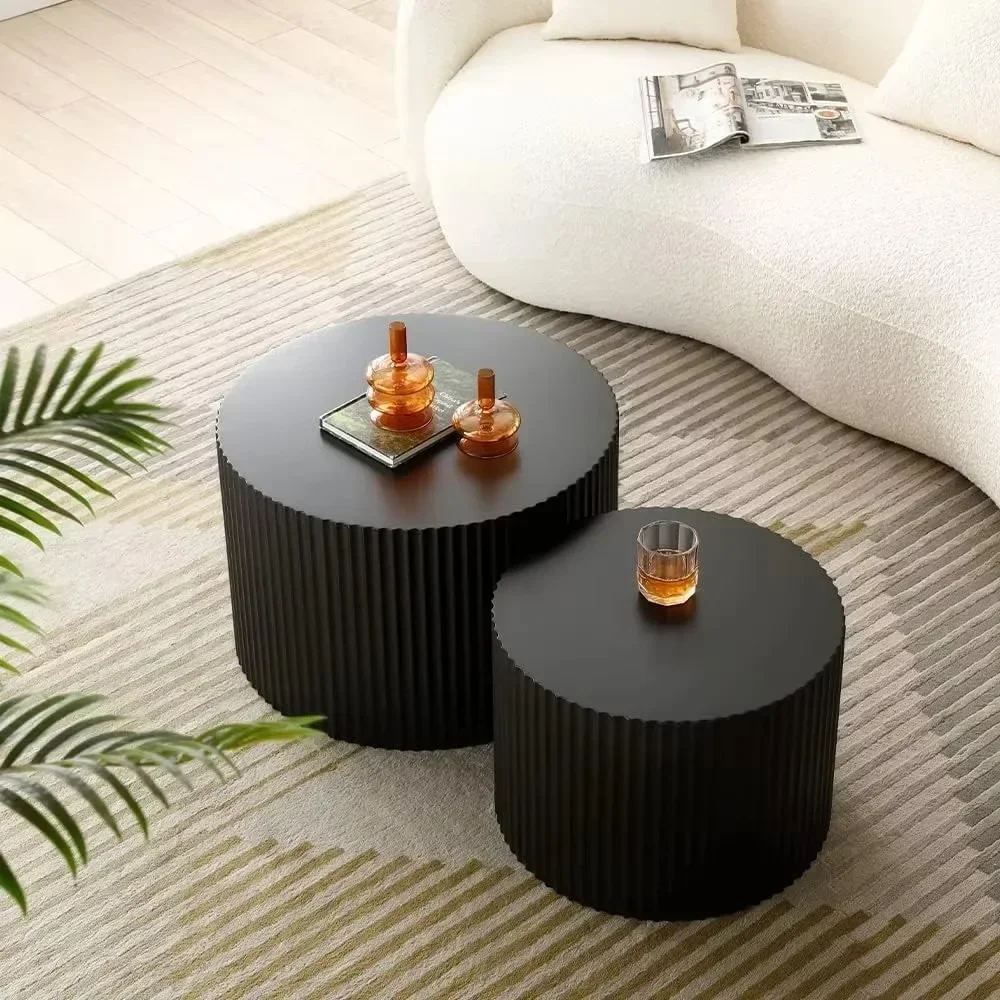
Mid-century modern nesting coffee tables capture the essence of this enduring design movement with their clean lines, organic influences, and perfect balance of form and function. These pieces remain relevant decades after their inception because their design principles transcend trends.
Authentic Mid-Century Design Elements:
– Tapered legs that angle outward, creating a sense of lightness and movement
– Gentle organic curves balanced with geometric precision
– Warm wood tones, particularly walnut, teak, and rosewood
– Minimal ornamentation that lets materials and proportions speak for themselves
Mid-century modern nesting table sets feature careful attention to proportion and scale. The relationship between table heights, the angles of supports, and the thickness of surfaces all contribute to their harmonious appearance. These considerations reflect the mid-century commitment to thoughtful, intentional design.
The beauty of these classic designs lies in their versatility. While they honor historical design principles, they integrate seamlessly into contemporary interiors, complementing both vintage and modern furnishings. Their enduring appeal makes them wise investments that will remain relevant through changing design trends.
Scandinavian Simplicity: Clean Lines and Natural Elements
Scandinavian-inspired nesting coffee tables embody the region’s design philosophy of simplicity, functionality, and connection to nature. These pieces combine practicality with understated beauty, creating an atmosphere of calm clarity in living spaces.
Distinctive Scandinavian Design Features:
– Light wood finishes like natural ash, birch, and oak that brighten spaces
– Minimal silhouettes with thoughtful proportions and subtle details
– Soft, pale color palettes occasionally punctuated by controlled pops of color
– Clean lines softened with subtle organic curves and natural materials
The Scandinavian approach differs from other minimalist styles through its emphasis on coziness (hygge) alongside functionality. These nesting tables often incorporate subtle rounded edges, tactile finishes that invite touch, and natural materials that bring warmth to otherwise spare designs.
This style works particularly well in spaces seeking to create a bright, airy feeling. The light wood tones reflect natural light, making rooms feel more spacious and connected to the outdoors. The uncluttered forms contribute to a sense of order and calm that characterizes Scandinavian interiors.
Industrial Edge: Raw Materials and Utilitarian Appeal
Industrial-style nesting coffee tables bring workshop-inspired character and rugged authenticity to living spaces. These designs celebrate raw materials, visible construction, and utilitarian elements that reference manufacturing and urban environments.
Industrial Design Characteristics:
– Exposed metal frameworks with visible joints and connections
– Reclaimed wood showing marks of previous use and authentic age
– Concrete and raw stone with natural imperfections left visible
– Functional hardware like wheel casters, adjustable heights, or visible bolts
The charm of industrial nesting tables lies in their honesty—they display their construction methods and material properties rather than concealing them. This transparency creates pieces with authentic character and historical references that add depth to contemporary spaces.
Maximize small spaces with nesting coffee tables that feature industrial design elements, as they often incorporate space-saving mechanisms originally developed for workshops and factories. Many include features like adjustable heights, swivel tops, or wheels that enhance their flexibility while staying true to their utilitarian inspiration.
Contemporary Minimalism: Refined Forms and Innovative Materials
Contemporary minimalist nesting coffee tables distill furniture to its essence, focusing on refined proportions, exceptional craftsmanship, and innovative material applications. These pieces create sophisticated, uncluttered interiors through their restrained approach to design.
Defining Contemporary Minimalist Features:
– Reduced forms that prioritize negative space and visual lightness
– Innovative materials including engineered surfaces, composite woods, and technical metals
– Monochromatic or subtly graduated color palettes that emphasize form over color
– Hidden details that reveal themselves only through closer examination and use
What distinguishes quality minimalist design is the precision of its execution—perfectly aligned joints, expertly finished surfaces, and thoughtfully resolved transitions between elements. These seemingly simple pieces actually require exceptional attention to detail, as there are no decorative elements to distract from any imperfections.
Contemporary minimalist nesting tables adapt well to evolving interior design trends because their restrained aesthetic provides a neutral foundation that complements changing decorative elements around them. Their clarity of form creates a sense of calm in busy environments and allows other design elements to shine.
Smart Storage Solutions: Functional Features Beyond Surface Appeal

Today’s nesting coffee tables often incorporate clever storage features that enhance their functionality without compromising their aesthetic appeal. These thoughtfully designed elements address practical needs while maintaining the clean lines and proportions essential to quality design.
Integrated Storage Features:
– Hidden drawers that preserve clean silhouettes while providing discreet storage
– Lift-top mechanisms that create adjustable work surfaces or reveal compartments
– Integrated magazine racks and display shelves that organize without cluttering
– Convertible designs that transform from coffee tables to dining or work surfaces
The most successful designs integrate these functional elements seamlessly, so they enhance rather than detract from the table’s appearance. Subtle finger pulls instead of hardware, precision-engineered lifting mechanisms, and thoughtfully proportioned storage compartments maintain design integrity while adding practical value.
Nesting coffee tables with integrated storage solve multiple challenges in contemporary living spaces—they provide flexible surface area, adaptable arrangements, and organized storage in a single design solution. This multifunctionality makes them particularly valuable in smaller homes where every piece must earn its place.
Selecting the Ideal Nesting Coffee Tables for Your Space
Choosing the perfect nesting coffee tables requires thoughtful consideration of both practical needs and aesthetic preferences. Taking time to assess your space and how you’ll use these versatile pieces will ensure they enhance both the function and beauty of your living area.
Essential Selection Factors:
– Room dimensions and proportions (allow 18-24 inches between table and seating)
– Existing furniture heights (coffee tables should be 1-2 inches lower than seat height)
– Traffic patterns and accessibility needs (consider clearance for movement)
– Lifestyle considerations (entertaining frequency, children, pets)
– Material durability requirements based on expected use
When measuring your space, don’t consider just the footprint of the nested tables but also their fully extended configuration. Ensure you have adequate room to separate the tables without creating obstacles or crowded pathways.
The proper placement of round coffee tables differs somewhat from rectangular ones—round tables require slightly more surrounding space to accommodate their shape but create better flow in tight areas due to the absence of corners.
Balance your desire for statement design with practical considerations. A stunning stone-top table may be impractical for a household with young children, while a delicate glass design might not withstand frequent entertaining. Choose materials and designs that align with how you actually live rather than an idealized version of your lifestyle.
Expert Styling Tips: Showcasing Your Nesting Tables
Once you’ve selected your perfect nesting coffee tables, thoughtful styling will help showcase their design while enhancing your overall interior. These versatile pieces offer countless arrangement possibilities for both everyday living and special occasions.
Arrangement Strategies:
– For daily use, try partially nesting tables with the smallest pulled slightly out to create layered depth
– When entertaining, fully separate tables and place them strategically for easy guest access
– Create asymmetrical arrangements by positioning smaller tables at angles to the larger ones
– For seasonal displays, group tables together with varied heights for dimensional decoration
The best ways to use nesting tables for entertaining involve thinking beyond the conventional. Rather than simply separating tables, consider using one near a reading chair for books, another as a bar station, and keeping the largest in its traditional position.
Styling Accessories That Enhance Nesting Tables:
– Books and magazines (arrange in small, neat stacks rather than tall piles)
– Natural elements like small plants, flowers, or interesting stones
– Decorative boxes that combine beauty with hidden storage
– Trays that corral smaller items into organized groupings
Mid-Century Modern Glass Top Coffee Tables, Mid-Century Modern Glass Top Side & End Tables
$460.58 Select options This product has multiple variants. The options may be chosen on the product pageMid-Century Modern Glass Top Coffee Tables, Mid-Century Modern Vintage Coffee Tables, Mid-Century Modern Vintage Side & End Tables
$725.36 Select options This product has multiple variants. The options may be chosen on the product pageMid-Century Modern Large Coffee Tables, Mid-Century Modern Rectangular Coffee Tables
$603.26 Select options This product has multiple variants. The options may be chosen on the product pageMid-Century Modern Marble Top Coffee Tables, Mid-Century Modern Rectangular Coffee Tables, Mid-Century Modern White Coffee Tables
Price range: $163.28 through $189.22 Select options This product has multiple variants. The options may be chosen on the product pageMid-Century Modern Nesting Coffee Tables, Mid-Century Modern Nesting Table Sets
$361.45 Select options This product has multiple variants. The options may be chosen on the product pageMid-Century Modern Rectangular Coffee Tables, Mid-Century Modern White Coffee Tables
$605.68 Select options This product has multiple variants. The options may be chosen on the product page
When styling, follow the rule of three—group objects in odd numbers for more pleasing compositions. Vary heights, shapes, and textures while maintaining a cohesive color story. Remember that negative space is essential; avoid cluttering your tables with too many objects, which can diminish their design impact.
Material Care Guide: Preserving the Beauty of Your Tables
Proper maintenance ensures your nesting coffee tables remain beautiful for years to come. Different materials require specific care approaches to preserve their appearance and structural integrity.
| Material | Regular Cleaning | Special Care | Protection Tips |
|---|---|---|---|
| Wood | Dust with soft cloth; clean with damp cloth and mild soap | Apply furniture polish or oil 2-4 times yearly; keep away from direct sunlight | Use coasters for drinks; avoid extreme temperature changes |
| Metal | Wipe with soft cloth; use appropriate metal cleaner | Apply protective wax to non-painted metals; touch up paint chips promptly | Protect from scratches; use felt pads under objects |
| Glass | Clean with glass cleaner and lint-free cloth | Check and tighten supports regularly; avoid impact to edges | Use coasters for hot items; place protective pads under hard objects |
| Stone/Marble | Dust regularly; clean with stone-specific cleaners | Apply sealant annually; clean spills immediately | Use coasters and placemats; avoid acidic substances |
| Natural Fibers | Vacuum with brush attachment; spot clean | Keep away from excessive moisture; reshape if distorted | Rotate displayed items to prevent uneven wear |
For all materials, prevention is the best approach to maintenance. Use appropriate pads and coasters, clean spills promptly, and position tables away from direct heat sources and sunlight when possible. Regular dusting prevents build-up that can become more difficult to address over time.
With proper care, quality nesting coffee tables will maintain their beauty and functionality for many years, making them a worthwhile investment in your home’s comfort and style.
Are Nesting Coffee Tables a Passing Trend or Timeless Investment?
Nesting coffee tables have demonstrated remarkable staying power in interior design, with their basic concept remaining relevant across decades of changing styles. This longevity stems from their fundamental combination of practicality and aesthetic versatility rather than trendy design features.
The most enduring nesting table designs share key characteristics:
– Clean, balanced proportions that transcend specific style periods
– Quality materials selected for both beauty and durability
– Thoughtful construction methods that allow for movement without degradation
– Versatile forms that complement various interior styles
While specific design elements may rise and fall in popularity—from brass finishes to particular wood tones—the core concept of nesting tables continues to offer relevant solutions for modern living. Their space efficiency and adaptability align perfectly with contemporary needs for flexibility in home environments.
From a sustainability perspective, mastering mid-century nesting coffee tables and other timeless designs represents responsible consumption. Well-crafted pieces that serve multiple functions and remain aesthetically pleasing for decades reduce the need for frequent replacement and the associated environmental impact.
Rather than viewing nesting coffee tables as either trend or investment, consider them functional design solutions that can be both timely and timeless depending on the specific execution. By selecting designs with balanced proportions, quality materials, and versatile styling potential, you invest in pieces that will serve your home beautifully for years to come.

